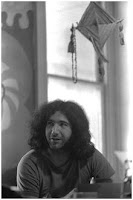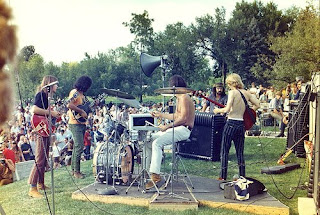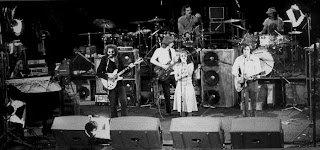Sunday, September 3, 1967
Dance Hall, Rio Nido, CA
Soundboard Recording
In March of 2000, Rio Nido ’67 leaked into circulation. I was a lucky early recipient of the show on CD and found myself compelled to review it almost immediately on the pages of Dead Net Central. Exuberant with not only the music, but with what this tape meant in the fabric of the Dead’s historical document, I sounded a bit like I had just returned from having had a religious experience while retreating on a commune somewhere. I suppose that was pretty much the case. Below is a slightly edited copy of that review.
This is SERIOUS, folks. This show stands (for me) as the pinnacle example of the raw psychedelic power that emanated from the Dead in the early years. This show gives us a glimpse into the true heart of one of the greatest turning point years in the band’s history. What 3/18/67 shows us of the bridge between 1966 and 1968, Rio Nido captures far more clearly. This show has completely flipped my wig. If you don’t have it yet, seek it out at all costs. This show is a classic beyond belief. This show makes me weep for all the other shows from this period that we’ve never heard, and may never still.
 I can hardly attempt to chronicle every song from this show. That won’t be necessary. You don’t even need to get more than three minutes into the opening Dancin’ In The Streets to realize what you have here. That puts you about 45 seconds into Jerry’s solo. He is solidly in that groove where he is seamlessly weaving rock, folk, Indian, and acid into his guitar playing. But instead of his reaching glimmers and moments of this, as he does so breathtakingly on 3/18/67, his solos on 9/3/67 are infused with this sense every step of the way. His note selection, tone, and amazing knack for getting caught in repetitive spiralings of phrases are uncanny. At this point Jerry has honed his love of Indian/Eastern tones and phrasing far beyond the greatness of 3/18/67. And when he adds in the bluegrass flavor, he becomes untouchable. All of this coalesces into the music’s overflowing ability to draw one into the present moment where there is little else but you and the music – a forced meditation fueled by 1967 psychedelic rock. Seeing this show (and really, this must be true for any of the shows we don’t have on tape from this stretch of 1967) must have been incredible. There could be no escape. No let down. No rest. I’ve always fancied that Jerry reached a God-like status on 3/18/67, and that anyone within earshot was destined to follow the band for the next 28 years. You can just sense the slack jawed expression on the faces of the audience as he ripped out his solo on The Same Thing and Viola Lee Blues. But it’s nothing compared to 9/3/67. The things that Jerry does, and Phil (oh my God! Phil!!!) go above and beyond.
I can hardly attempt to chronicle every song from this show. That won’t be necessary. You don’t even need to get more than three minutes into the opening Dancin’ In The Streets to realize what you have here. That puts you about 45 seconds into Jerry’s solo. He is solidly in that groove where he is seamlessly weaving rock, folk, Indian, and acid into his guitar playing. But instead of his reaching glimmers and moments of this, as he does so breathtakingly on 3/18/67, his solos on 9/3/67 are infused with this sense every step of the way. His note selection, tone, and amazing knack for getting caught in repetitive spiralings of phrases are uncanny. At this point Jerry has honed his love of Indian/Eastern tones and phrasing far beyond the greatness of 3/18/67. And when he adds in the bluegrass flavor, he becomes untouchable. All of this coalesces into the music’s overflowing ability to draw one into the present moment where there is little else but you and the music – a forced meditation fueled by 1967 psychedelic rock. Seeing this show (and really, this must be true for any of the shows we don’t have on tape from this stretch of 1967) must have been incredible. There could be no escape. No let down. No rest. I’ve always fancied that Jerry reached a God-like status on 3/18/67, and that anyone within earshot was destined to follow the band for the next 28 years. You can just sense the slack jawed expression on the faces of the audience as he ripped out his solo on The Same Thing and Viola Lee Blues. But it’s nothing compared to 9/3/67. The things that Jerry does, and Phil (oh my God! Phil!!!) go above and beyond.Let me try to explain a bit further. On the opening Dancin’ in the Streets, Jerry starts his solo off with some huge lines. He’s wasting no time. He’s bending and cooing notes all over the place. His fuzzy electric tone is warm and textured. The entire time, he is playing outside of a traditional blues/rock scale framework. He doesn’t just work himself out of the songs traditional feel, he is long gone from it the whole time. As he moves along, he rolls off the treble more and more, until his notes sing like morning birds lamenting summer’s departure. His ability to infuse Indian melodies with this tone is remarkable. While doing this, it’s almost unbelievable that they are playing Dancin’ in the Streets. His guitar sings soft and haunting songs that defy simple human expression. It’s as if he is only a conduit for the voice of the music. This continual overlapping of incredible lines goes on and on. Soon we find Jerry beginning to grab lines and attach them as a seamless circle, running them round and round upon themselves. Without a giant crescendo, and with no need for one really, things settle back down into the framework of the song, and it wraps up. You’re just left standing there in awe.
 The Viola Lee, which eventually turned up featured as an extra track on the official re-release of the debut album in the Golden Road box set, cuts in on the last words of the first verse, giving us the full ride between verses. Early on, you can tell this is something special as you are lost in the classic Viola Lee triplet riff that goes on forever and ever here. This one threatens to trip you because Phil is an evil jester, ending and restarting the triplet on ever note but number three. You can just feel him grinning the whole time. They converge back on the song with some trouble, but save the day by somehow gathering themselves on the right downbeat. It makes for a fantastic moment, and launches one of the pinnacle psychedelic passages in the Dead’s musical history.
The Viola Lee, which eventually turned up featured as an extra track on the official re-release of the debut album in the Golden Road box set, cuts in on the last words of the first verse, giving us the full ride between verses. Early on, you can tell this is something special as you are lost in the classic Viola Lee triplet riff that goes on forever and ever here. This one threatens to trip you because Phil is an evil jester, ending and restarting the triplet on ever note but number three. You can just feel him grinning the whole time. They converge back on the song with some trouble, but save the day by somehow gathering themselves on the right downbeat. It makes for a fantastic moment, and launches one of the pinnacle psychedelic passages in the Dead’s musical history.The solo section starts off in a typical grungy Viola Lee fashion. Shortly, though, Jerry gets himself locked on a little two note pull-off that grabs your attention. Then the band seems to focus more. Bobby is flinging little riffs all over. Phil is breaking ever rule of key and tempo with amazing success. Billy picks things up a bit, and they’re off to the races. Jerry adds some bluegrass, while Phil is still breaking rules. What is easy for the ear to pick up here is Cumberland Blues. Not as a hint or tease of the actual song, but as a groove. I’ve always drawn strong lines between Viola Lee and Cumberland all the way through 1973. Here, the country coal mine two step is nicely explored. Next time you listen to a Cumberland from 1970-1973, listen for the Viola Lee Blues. It’s in there.
 Just as this is getting comfortable, Jerry moves outside the box with a minor key and what follows is brief but remarkable. He’s playing lines that should belong to Chuck Berry, but only if you dosed Chuck to the gills. For a moment it’s just Jerry and Billy. Phil comes back in with tons of power. He is starting to let a few notes just grow on their own, until he’s feeding back a bit. Jerry overlays this with some sitar-like flavors (the morning birds lamenting again), and then everything stops except for Billy’s hi-hat.
Just as this is getting comfortable, Jerry moves outside the box with a minor key and what follows is brief but remarkable. He’s playing lines that should belong to Chuck Berry, but only if you dosed Chuck to the gills. For a moment it’s just Jerry and Billy. Phil comes back in with tons of power. He is starting to let a few notes just grow on their own, until he’s feeding back a bit. Jerry overlays this with some sitar-like flavors (the morning birds lamenting again), and then everything stops except for Billy’s hi-hat.The Caution Jam comes in as if on cue. It is short-lived, but completely present. Jerry simply can’t be contained. He turns up the tone knob and kicks into gear. Phil is still working Caution, but Jerry is just nuts, going in and out of the Caution Jam time and time again. The beat is flying along. Now Jerry is caught in circular patterns again, while Phil is pulling notes up from underground. He (Phil) is demonstrating an amazing ability to expand the chord patterns of the song, until he’s completely playing noise. The rest of the band follows and they head into the traditional Viola Lee howling feedback section. A great time to forget the world around you and let the speeding waterfall of colors consume you. They bounce back to the Viola tune with their well-known precision. But, instead of heading to the last verse, they just let the jam develop all over again. Bobby is playing with a brute strength, crushing notes and chords in his path. Phil does a slow stair stepping of notes that is magnificent, pulling every last breath of harmony out of the song’s structure. Just when you completely forget that the end of the song was coming, Jerry brings the beast under control and the last verse begins. Yes, the cut comes only seconds into the Feedback that would end the song, and it hurts. But, boy oh boy! We are blessed to have what we have.
 The Alligator is another great example of this 1967 power. Booby’s chords at the start are dynamite. The jam gives Bobby room to move too. He is playing loud and strong. Jerry’s playing has time shifted a few months into the future, touching everything we would later hear from him in the early months of 1968. It’s no doubt that this song opened the doors of the next year. You can even hear hints of Jerry’s China Cat runs as he works in a Mountain Jam to the fabric of his Alligator solo.
The Alligator is another great example of this 1967 power. Booby’s chords at the start are dynamite. The jam gives Bobby room to move too. He is playing loud and strong. Jerry’s playing has time shifted a few months into the future, touching everything we would later hear from him in the early months of 1968. It’s no doubt that this song opened the doors of the next year. You can even hear hints of Jerry’s China Cat runs as he works in a Mountain Jam to the fabric of his Alligator solo.Then the Midnight Hour (officially released on Fallout From The Phil Zone) rounds out the set. An epic version, not only based on its length (31 minutes) but also for containing a tremendous Pigpen rap. My favorite bit comes while the entire song seems to moving along as nothing more than a groovy dance hall number, keeping people up on their feet and having a good time. But then the wind shifts and Jerry starts oozing notes with his volume knob, and a landscape of slow motion explosions and molten puddles of empty space fill the world before you. It passes as quickly as it comes, but leaves you nervous that things aren't quite as safe as you thought. A great Grateful Dead moment.
 So much pleasure from a little over an hour and a half of music seems almost unfair; nearly as much so as the pain of all that missing music from 1967 overall. But, perhaps the former is elevated by the latter. Maybe the circumstances that lead our particular thread of a universe to bring us what music it did simply followed a familiar human adage among its fellow universes: One man gathers what another man spills.
So much pleasure from a little over an hour and a half of music seems almost unfair; nearly as much so as the pain of all that missing music from 1967 overall. But, perhaps the former is elevated by the latter. Maybe the circumstances that lead our particular thread of a universe to bring us what music it did simply followed a familiar human adage among its fellow universes: One man gathers what another man spills.An equal blessing is that the band allows us to stream this entire show (officially released Viola Lee Blues and Midnight Hour included) on the archive.
09/03/67 SBD etree source info
09/03/67 SBD Stream






















